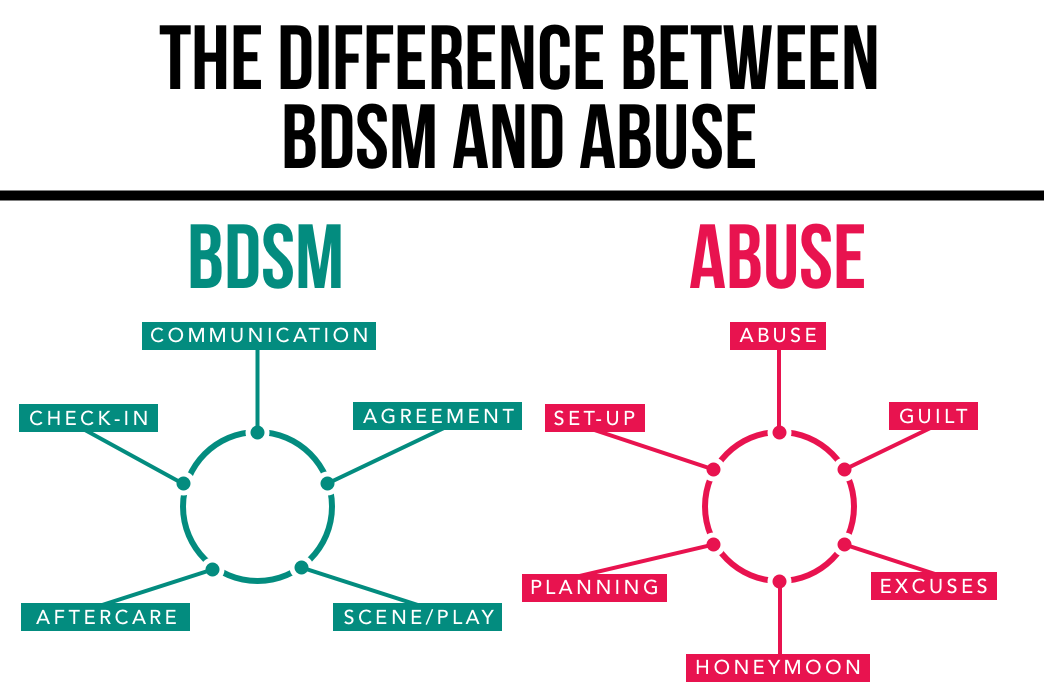This writing is now available as a podcast episode!
This is a question that comes up a lot. In my general Kinky Q&A classes, online by newbies, or people who love someone kinky and are seeking to understand them, and in other classes (like cuckolding) that look to outsiders like horrific relationships going very very wrong.
I think most of us know abuse when we see it, although I’m guessing we’ve all been wrong before as well.
It’s discussing abuse with others, or catching it in our own relationships where it can get tricky.
Having the right words to draw the line in the sand, and looking beyond infatuation and ego…
Well, it’s difficult.
In my February book, So, What is Kinky, Anyway?, I put a bit of effort into giving some clear examples of consensual BDSM/kink versus abuse.
I’d love your feedback.
*smiles*
Let’s compare and contrast consensual kink and abuse:
Kink: Using body/mental sensations such as pain, pleasure, humiliation and love to elicit pleasure and release.
Abuse: Causing physical and/or mental/emotional harm to another person.
Kink: Consensual power exchange where both partners negotiate and agree, empowering themselves within an agreed-upon framework.
Abuse: Takes away power from one partner.
Kink: Actions and relationships are communicated, negotiated, and agreed to.
Abuse: There is no agreement to when/how it will happen, and there is no consent to it happening.
Kink: Creates excitement in each partner for the other.
Abuse: Creates fear of one partner for another.
Kink: Fosters and builds trust.
Abuse: Destroys trust.
Kink: Intended to fulfill the desires and needs of all involved within a safe environment.
Abuse: Focuses on the needs and desire of just one, creating a cruel and possibly violent environment for the other.
Kink: Communication and support create an environment where it’s safe to talk about wants, needs, thoughts, and emotions.
Abuse: No support. Communication is usually one-sided (if it happens at all), and wants, needs, thoughts, and emotions are not safe.
Maybe you think you’re kinky (or know you are), and those contrasts are resonating with you.
Maybe, though, you’re reading this because you want to understand a friend or loved one’s kink more, and really, it just still seems pretty abusive to you.
It ought to be OK to take their word that they want this, but are there ways you can be sure?
Honestly, not really. Well, not unless it’s over time.
However, there are some clues that might help, especially with the physical play and marks that can seem so scary:
There are no defense wounds. People in abusive situations will often raise their hands/arms to protect their face, and will have secondary wounds from the impact. People in kink welcome their play. There are exceptions where, for example, primal or rough body play engages the whole body. Listen for words like that when you ask after their well-being.
Concentration of “damage.” Kink can often leave some pretty scary marks, especially from paddles, “evil sticks,” whips, canes, etc. However, they are usually fairly concentrated in specific areas: buttocks, thighs, back, breasts, and genitals. Rarely will you see random areas or very public spots like the face touched in kink, except (again) in primal/rough body play.
Kinky toys. While kink can be performed with pretty much anything (there are entire groups devoted to “pervertibles,” or everyday objects you can use to make people feel something in kink—like wooden spoons, wood clamps, even tinsel), most kinky people will have at least a small collection of toys, like handcuffs, floggers, paddles, gags, etc.
Language. Kinky people have very specific language around what we do. We use the term “marks” instead of “wounds” or “scars.” “Power exchange” or “D/s” to refer to relationship dynamics. They might mention SSC, RACK or PRICK. And so on. Consent will be mentioned. A LOT.
Pride/defiance, instead of fear. Not only will kinky people mention consent, but if you question us, we will often get downright offended that you don’t think we’re telling the truth, or that we don’t have a right to choose how to use our bodies with partners for our own pleasure and fulfillment.
HARD TRUTH: You cannot be sure.
People CAN be both kinky and abusive.
To say otherwise would be lying.
And people can THINK they are in a consensual kinky relationship, then suddenly one day realize they were lied to and emotionally abused into consenting.
That’s a part of life.
Nothing is ever ONLY good, including kink.
But if the kinky person is your friend or loved one, you may just have to take their word for it, and support and love them as hard as you can, even if you don’t understand.
Because that is how you will keep the relationship, and if, ever, anything turns out to go wrong (even if it’s not abuse, but just a relationship meltdown), that’s how you will be there to help them pick up and move on.
Bottom line is…
Kink is many things to many people: exciting, scary, overwhelming, exhausting, breathtaking, and more.
It should always be consensual, with everyone involved feeling like they are supported in communication and realization of their needs and desires and that they may opt-out (with no negative repercussions) at any time.
Without that feeling, it’s abuse.
It may ALSO be kinky. But being kinky does not in any way make abuse OK.
What are your thoughts?
Of course, there might be times when one or a couple of these apply to even non-abusive relationships.
And times when abusive relationships seem to have some of these markers as well.
There is no hard-and-fast rule to judge a relationship, except to take it as a whole, and weigh everything out. Even therapists I talk to (who are kink-aware and kink-friendly) say this.
But these are the guidelines I’ve found online and put together through talking to others.
What are your thoughts? Anything I’ve missed?











2 Responses
I strongly believe that ANY kind of relationship is built on Trust and Communication: Vanilla Romantic, D/s, Friendship, Workplace, etc. To truly build a good relationship takes time, but time should be taken before any type of kinky play to really talk. Even as a Pro Domme, I talk to my subs 30-45 minutes before we play the first time, and then 20-30 minutes either before or after play subsequent times. I even have them journal! People get so excited about playing that they tend to either skip or skimp on this step and that could be the difference between a one time experience or a relationship that develops over years! Not only do you need to discuss safety and basic protocol ( (a necessity – I use a Green, Yellow, Red system as opposed to a safeword and ask about hard limits), but ask questions like what drew them to BDSM, what has their experiences been, good and bad. What things are they curious about? I have heard so many different stories, there is no way to possibly categorize what path has led them to their kink – good, bad, and ugly. LISTEN – don’t just wait for a pause so that you can start talking! With a BS in Communications, I am able to use their tone, infection, cadence, nonverbal cues, etc. but I don’t think you really need a degree if you just pay close attention and show true interest in what they are saying. Doing all of this can help to build a healthy kinky relationship. That’s not to say that there won’t be exceptions…especially because the excitement of play can overwhelm someone who may ask all the right things, but not truly listen or show the person the respect they deserve.
I totally concur! <3